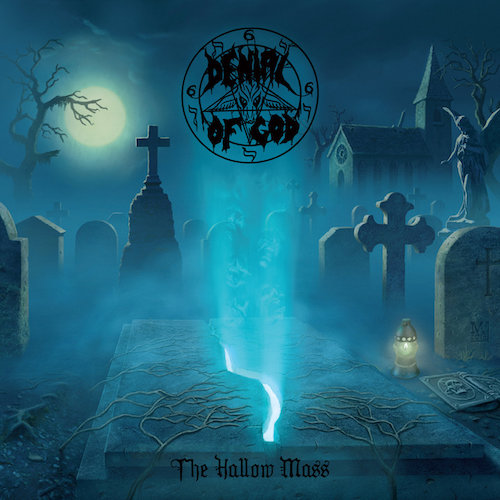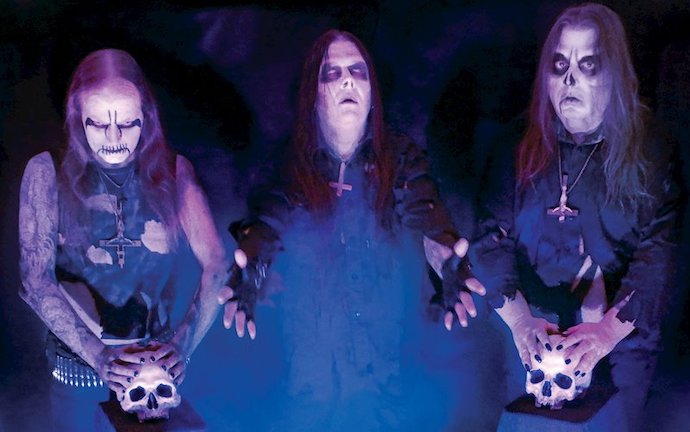Denial of God are a distinctive presence in the long ranks of black metal bands. For one thing, the Danish brothers Azter (guitars) and Ustumallagam (vocals) have been creating music under that name since 1991. Apart from the fact that few bands have lasted so long, Denial of God have also crafted an unusual aesthetic for their music, moving in increasingly cinematic and theatrical directions, with a pronounced supernatural atmosphere, that has given birth to the description of their creations as “Black Horror Metal”.
Seven long years have passed since the band’s last album, Death and the Beyond, with only The Shapeless Mass EP (released this past June) as a sign of renewed activity. That EP was intended as a springboard into a new full-length, and that new album is now fast approaching. Entitled The Hallow Mass, it will be jointly released by Osmose Productions and Hells Headbangers this coming Friday, October 25th, and today it’s our privilege to bring you a complete stream of this massive new work.
And yes, this third Denial of God album really is massive — a 63-minute record that consists of six mostly very long tracks (five of them range from 9 minutes to more than 14) and an intermezzo that leads into the album closer. Once again, Azter and Ustumallagam are in harness together, joined again (as on the first two albums) by drummer Galheim (whose work here is terrific).
The preceding references to a cinematic and theatrical aesthetic might not seem exactly on-point, if what you were expecting were panoramic synths or bombastic symphonics. And the references to horror might also be misinterpreted, if what you were expecting was thoroughly ghoulish or vampiric atmosphere. The meaning of those descriptive terms is different in the context of what Denial of God have wrought through this expansive and immersive album.
No doubt, the dramatic sounds of thunder and lightning at the outset of the opening track “Hallowmas” could be a scene-setter for graveyard terrors, but the slow piano melody that emerges against the backdrop of mystical shimmer provide a glimpse of what proves to be one of the album’s strengths — the heart-felt (and often heart-breaking) melodies. And when the song explodes in a surge of heavy riffing and tumultuous drumming, of vicious snarls and racing bass notes, you’ll know that this isn’t typical of what passes for “cinematic” metal.
The song’s full-throttle aggression, however, is balanced by bursts of sky-bound melody and head-hooking riffs. And the song is also a fine example of another recurring feature of the album, which is Azter‘s impressive ability to establish a melody and then work variations on it over the course of these long songs, using crystalline rippling chords to create harmonies with the harsher rhythm guitar, and seamlessly changing the emotional resonance of them through those variations, making them both moodier and more fiery.
To be sure, there are moments of bombastic extravagance in “Hallowmas”, along with frightening cackles by Ustumallagam, but also bright, dancing keyboard motifs, and soulful, sorrowful soloing. Particularly with the clarity of the production, it has the quality of a dark rock opera.
And so, as that opening track reveals, the cinematic and theatrical aspects of the music reveal themselves in the narrative quality of the music. Instead of waves of synthesized sounds resembling a movie soundtrack, Denial of God create moving musical tales that evolve, while at the same time anchoring them with intensely affecting melodies that burrow deeper and deeper under the skin even as they undergo significant variations.
Some of the songs have more oppressive and frightening moments than others (“Undead Hunger” is one of those — though its mid-section is bright and buoyant), but all of them include passages of great poignancy and emotional depth. In other words, these aren’t “cheap thrills”, and although the songs do often have a paranormal, supernatural atmosphere, they seem equally rooted in very human emotions and tragic experiences, and there’s as much grandeur and glory to be found here as fear and doom.
To pick out another wonderful sequence, the fifth track “Hour of the Worm: is all hurtling drums, racing riffs, extravagant leads, and scalding vocal ferocity — a torrent of electrifying savagery. Yet other dimensions are revealed as the song proceeds. It becomes soft and spooky, slow and sinister, with vaporous melodies that smell ominously of poison. And the sinister, morbid strands in the music then become increasingly unhinged as the guitar heats again to a boil.
Yet further changes still lie ahead with that intermezzo mentioned earlier, “A Thousand Funerals”. Here, organ harmonies slowly reverberate, drawing a curtain of sorrow across the heated sulphurous flurries of the preceding track. And this in turn is followed by the beautiful segue into the long closing track, “The Transylvanian Dream”. A beguiling yet melancholy guitar instrumental with an almost medieval air leads us into the song. Adapting that melody through a rippling tremolo lead, the band then carry it forward in a rush as Ustumallagam‘s harsh snarling voice returns (somehow clearly pronouncing the words despite the bestial quality of what comes from his throat).
The music whirls and dances, spinning, leaping, and darting in a union of mad ecstasy and mortifying anguish — until a combination of balalaika-like harmony and slow strumming shift the mood of the music into a more introspective yet also more despairing kind of intensity. That episode is so piercing and so heart-rending that it becomes one of the song’s signal moments. And when the song ramps up again into a surge, the variations on the melody change its feeling again and again, though without losing the melodic thread that ties the track together, and that causes the music to powerfully linger after the song (and the album) come to a close.
In the preceding paragraphs I didn’t give specific attention to “The Shapeless Mass” or the mesmerizing “The Lake In The Woods”, but only because I didn’t want this to review to reach book-length. They are every bit as dynamic, as evolving, and as immersive as the other main songs. They have the capacity of making us feel as if we’ve entered worlds of wonder, or of myth, and there’s a mythic quality to the album as a whole.
To repeat, The Hallow Mass will be released by Osmose and Hells Headbangers on October 25th. The wonderful cover art was created by Markus Vesper.
PRE-ORDER:
https://osmoseproductions.bandcamp.com/album/the-hallow-mass
https://www.osmoseproductions.com/
https://denial-of-god.bandcamp.com/album/the-hallow-mass
DENIAL OF GOD:
https://www.facebook.com/denialofgod
https://www.denialofgod.net



man, this is one album I have been waiting for!!! for some reason this band just resonates with me in a way that say, Cradle Of Filth does not, they have an almost Mercyful Fate type of vibe for the Black Metal genre IMHO!!! this new one and there album “Death And The Beyond” are excellent!!!
Yes, definitely atypical for black metal (the Merycful Fate reference is a useful one). There’s a lot of “classic” heavy metal in their music, and a brilliant feel for affecting melody to go along with the supernatural atmosphere and the frightening vocals.
I feel guilty listening to all the tracks before the official release, but they’re so good I can’t help myself. And Vesper’s cover art is fantastic.
The album really proved to be a big surprise for me, one of the most memorable records of the year in what I’ve heard.